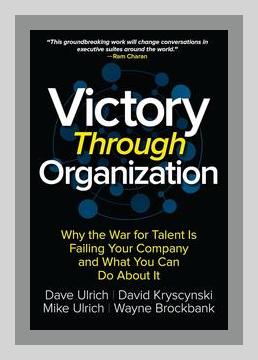Human Resources and Talent ManagementRecruitment and HiringHR Technology
Summary of “Victory Through Organization: Why the War for Talent is Failing Your Company and What You Can Do About It”
Introduction:
“Victory Through Organization,” authored by Dave Ulrich, David Kryscynski, Michael Ulrich, and Wayne Brockbank, delves into the critical domain of human resources and challenges the prevalent ideology that a company’s success is solely reliant on hiring top talent. Instead, the authors argue convincingly that organizational effectiveness, driven by strategic HR practices, is the key to sustainable success.
1. Rethinking the Talent Paradigm:
Main Point: The book begins by questioning the popular narrative of the ‘war for talent’ which suggests that hiring the best and brightest is the ultimate solution for organizational success. Instead, it promotes the idea that the capacity of the organization to turn individual talent into organizational capability is the real differentiator.
Action: Emphasize developing strong organizational routines, capabilities, and collaborative environments over simply recruiting star performers.
Example: The authors discuss the example of Google, which is reputedly challenging the notion of individual brilliance by focusing on effective teamwork. Google’s Project Aristotle revealed that the best teams at Google were not those populated with individual superstars, but those with a high degree of interpersonal sensitivity and respect among team members.
2. The Role of Organizational Capabilities:
Main Point: Organizational capabilities such as agility, collaboration, customer orientation, and innovation are presented as more enduring competencies than individual talents.
Action: Identify and cultivate specific organizational capabilities that align with your strategic goals.
Example: Apple’s ability to innovatively blend hardware, software, and services into a coherent user experience is an organizational capability that has sustained its competitive advantage, despite frequent leadership changes and the arrival or departure of individual stars.
3. HR Practices and Their Impact:
Main Point: The book delves into how specific HR practices can foster organizational capabilities. Traditional HR functions need to be integrated and aligned with the business strategy to create a coherent system that drives organizational effectiveness.
Action: Evaluate and redesign HR practices to ensure they support the creation and nurturing of targeted organizational capabilities.
Example: The authors describe General Electric’s (GE) use of boundaryless behavior as an HR practice to encourage knowledge sharing and collaboration across divisions, leading to seamless operations and innovative solutions effectively embedding enterprise-wide capabilities rather than isolated pockets of talent.
4. Leadership and Organizational Culture:
Main Point: Effective leadership is key to fostering a culture that promotes organizational capabilities. Leaders should act as facilitators who shape and reinforce desired behaviors and capabilities.
Action: Develop leadership programs that emphasize building and nurturing organizational culture and capabilities rather than just individual leadership skills.
Example: IBM’s turnaround under Louis Gerstner involved a significant cultural shift from a bureaucracy-bound organization to a more agile and customer-focused enterprise. Gerstner prioritized changing the culture to promote this transformation, demonstrating that leadership committed to driving cultural change can lead to substantial organizational improvements.
5. Investing in HR Professionals:
Main Point: For HR to drive significant organizational capability, HR professionals themselves must possess and continually develop the requisite skills and competencies.
Action: Invest in continuous learning and development for HR staff, ensuring they have access to the latest knowledge and tools to drive organizational capability.
Example: The authors found that organizations that invest in the upskilling of their HR professionals (e.g., through certifications, advanced HR courses, and exposure to various business areas) saw a more significant impact on overall business performance.
6. Data and Analytics in HR:
Main Point: Leveraging advanced HR analytics to make data-driven decisions enhances the effectiveness of HR strategies and practices in nurturing organizational capabilities.
Action: Implement robust HR analytics systems and cultivate a culture of data-driven decision-making within the HR department.
Example: Procter & Gamble’s (P&G) use of predictive analytics to anticipate talent needs and workforce trends helped streamline their HR processes, ensuring that HR strategies were informed by actionable insights, thus aligning talent management more closely with business objectives.
7. Aligning HR with Business Strategy:
Main Point: HR practices must be tightly aligned with the organization’s strategic priorities to effectively support and drive organizational goals.
Action: Involve HR leaders in strategic planning sessions and ensure that HR initiatives are designed to support and achieve the strategic vision of the organization.
Example: In the book, the authors cite PepsiCo, where HR plays a central role in strategic discussions. This alignment enables HR to design talent management and development programs that support PepsiCo’s growth strategies effectively.
8. Measuring HR’s Impact:
Main Point: Developing accurate metrics to measure HR’s contribution to business outcomes is crucial for demonstrating and enhancing HR’s value to the organization.
Action: Develop and implement a comprehensive set of metrics to assess the effectiveness of HR initiatives and their impact on organizational performance.
Example: The authors discuss how Deloitte’s “Human Capital” metrics go beyond traditional HR metrics to include business performance outcomes, providing a clear linkage between HR initiatives and business results.
9. External Stakeholder Engagement:
Main Point: Engaging with external stakeholders (customers, investors, suppliers) can provide critical insights and additional value which helps in shaping HR strategies that are more aligned with market needs.
Action: Establish regular forums for interaction with key external stakeholders to gather input and feedback on organizational performance and needs.
Example: Nike’s collaboration with external partners and communities not only enhances its social responsibility initiatives but also feeds into HR strategies that promote an inclusive and innovative work environment, reflecting market trends and stakeholder expectations.
Conclusion:
“Victory Through Organization” offers a transformative perspective on the role of HR in creating sustainable competitive advantage. Rather than focusing narrowly on individual talents, the book advocates for a broad-based approach where organizational effectiveness, bolstered by integrated HR practices, robust leadership, strategic alignment, and continuous learning, forms the foundation for enduring success. CEOs and HR professionals alike can find valuable insights and actionable strategies to align their organizations for higher performance and lasting impact.
Human Resources and Talent ManagementRecruitment and HiringHR Technology
